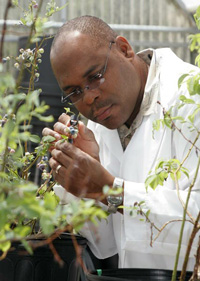Evaluation of Sampling Data to Reduce Frequency of Insecticide Application for Flower Thrips Control in Commercial Highbush Blueberry Plantings (Part 1 - Year 2006)
Project description and objectives:
Several species of flower thrips, including the Florida flower thrips, Western flower thrips, Eastern flower thrips have recently become known as pests of cultivated  blueberries. Flower thrips damage blueberry flowers in two ways. Both larvae and adults feed on all parts of the flowers including ovaries, styles, petals, and developing fruit. This feeding damage can reduce the quality and quantity of fruit produced. Females also cause damage to fruit when they lay their eggs inside flower tissues. The newly hatched larvae bore holes in flower tissue when they emerge. In Florida, several different southern highbush blueberry varieties are grown together on the same farm. These varieties differ in fruit and flower characteristics and in the timing and length of flowering period, which may lead to differences in thrips numbers and thrips injury among them.
blueberries. Flower thrips damage blueberry flowers in two ways. Both larvae and adults feed on all parts of the flowers including ovaries, styles, petals, and developing fruit. This feeding damage can reduce the quality and quantity of fruit produced. Females also cause damage to fruit when they lay their eggs inside flower tissues. The newly hatched larvae bore holes in flower tissue when they emerge. In Florida, several different southern highbush blueberry varieties are grown together on the same farm. These varieties differ in fruit and flower characteristics and in the timing and length of flowering period, which may lead to differences in thrips numbers and thrips injury among them.
We investigated the relationship between thrips numbers and marketable yield. Our objective was to determine whether different varieties of southern highbush blueberries respond differently to thrips infestation.
Project activities:
Samples of different varieties were taken from two commercial farms in Hernando County. White sticky traps and the collection and dissection of flowers were used to obtain samples. Each week throughout the flowering season sticky traps were collected and replaced with fresh traps and five flowers were collected from each plant. All samples were sent to the Small Fruit and Vegetable IPM Laboratory at the University of Florida in Gainesville for processing.
We also investigated the amount of fruit injury caused by thrips. At harvest, four plants adjacent to each sticky trap were sampled. Twenty five fruit from each plant were examined for thrips injury. The number of fruit injured to the point of being unmarketable was also noted.
Project accomplishments:
At farm A, Saphire, Sharpblue, and Winsor varieties had significantly less thrips per sticky trap than all of the other varieties. In contrast, the number of thrips per  sticky trap did not differ among the three varieties at the B farm. Different trends were observed in the flower samples. At farm A, Saphire had significantly less thrips per flower than all of the other varieties. The Saphire variety flowers at a later date and has a shorter flowering period than many of the other varieties. This may explain why thrips numbers per trap and per flower were lower for this variety. At farm B, there were less thrips per flower in the Winsor flowers compared with both the Jewel and Star flowers. The majority of thrips collected from the flowers were immatures. In contrast, sticky traps collected only adults.
sticky trap did not differ among the three varieties at the B farm. Different trends were observed in the flower samples. At farm A, Saphire had significantly less thrips per flower than all of the other varieties. The Saphire variety flowers at a later date and has a shorter flowering period than many of the other varieties. This may explain why thrips numbers per trap and per flower were lower for this variety. At farm B, there were less thrips per flower in the Winsor flowers compared with both the Jewel and Star flowers. The majority of thrips collected from the flowers were immatures. In contrast, sticky traps collected only adults.
Very few fruit were injured to the point of being unmarketable. The average number of injuired fruit did not differ significantly among varieties. This was probably because thrips numbers did not reach damaging levels during the season. Thrips levels were probably low due to the very dry weather this past spring (2006) and a flowering period that occurred early and was truncated. However, there was a trend towards Millennium and Misty having less injured fruit than the other varieties at the A farm and a trend towards Windsor having significantly less damage than Jewel at the B farm.
The varieties differed from each other in number of thrips per trap and per flower. Although not statistically significant, there were numeric differences in the numbers of injured fruit among varieties. These results lead us to believe that different varieties may respond differently to similar levels of thrips infestation.
Click here to see the report on this project (pdf 318KB)
Project leaders:
Dr. Gary England, Sumter County Extension
Dr. Oscar Liburd, Associate
Professor, Entomology
Elena Rhodes, Entomology
For more information on IPM of Fruits and Vegetables: http://entomology.ifas.ufl.edu/liburd/fruitnvegipm/


